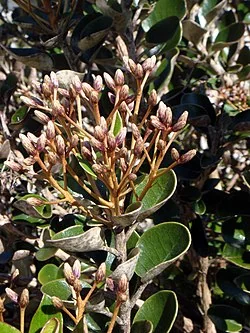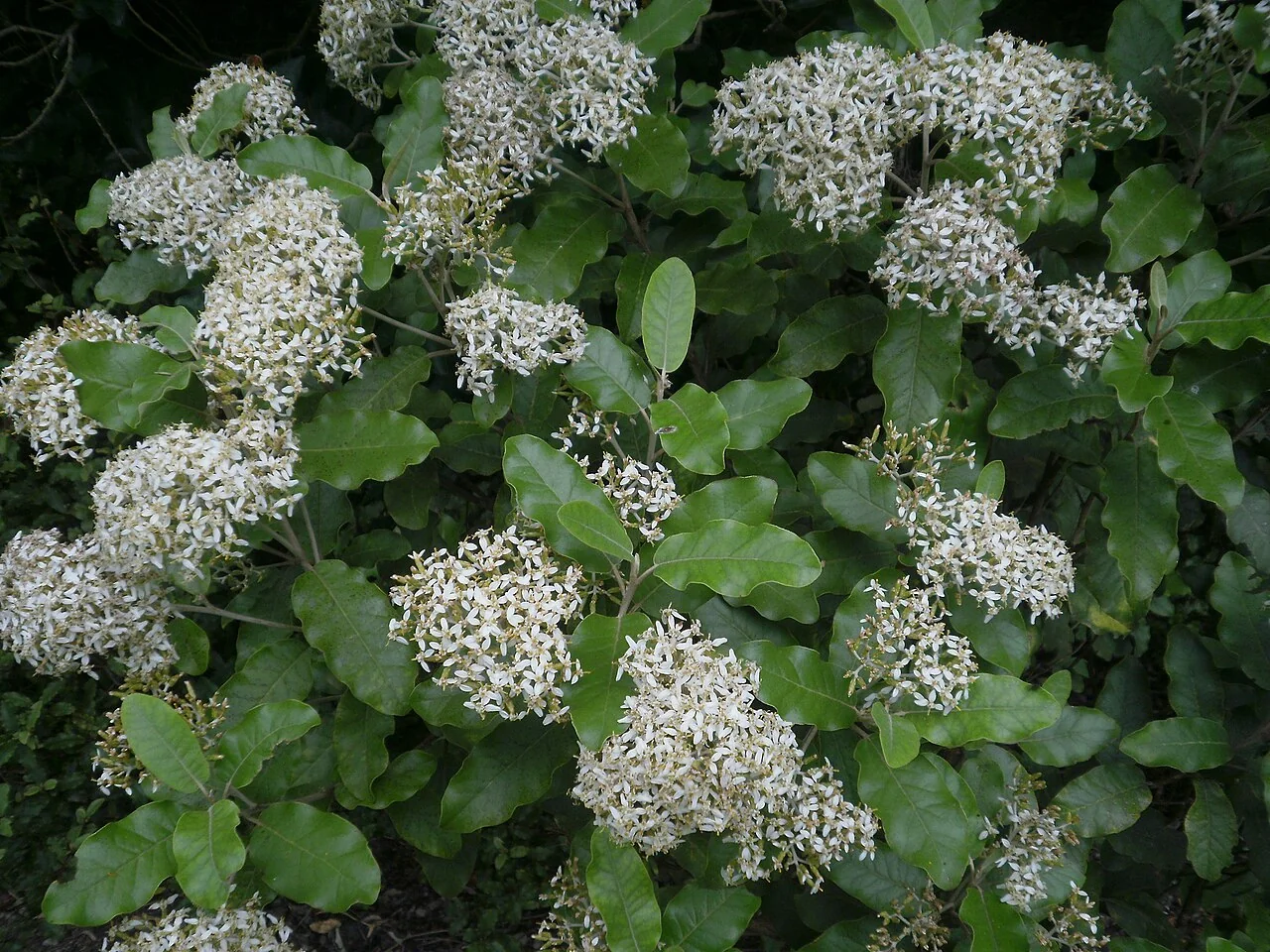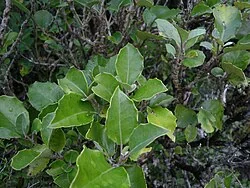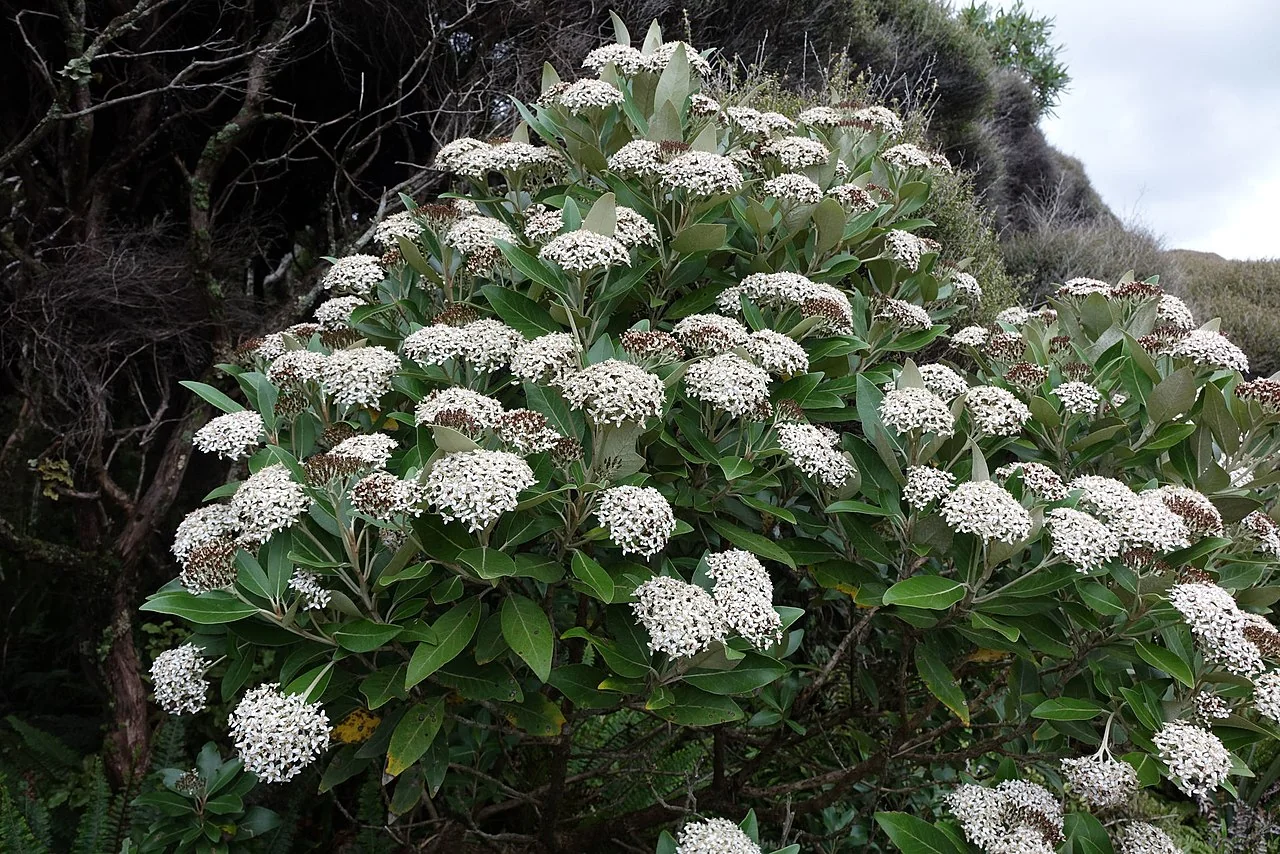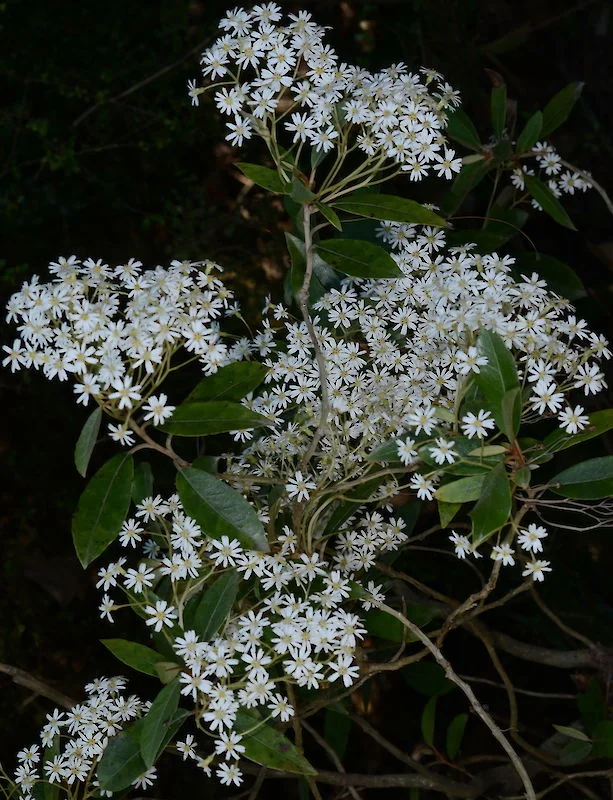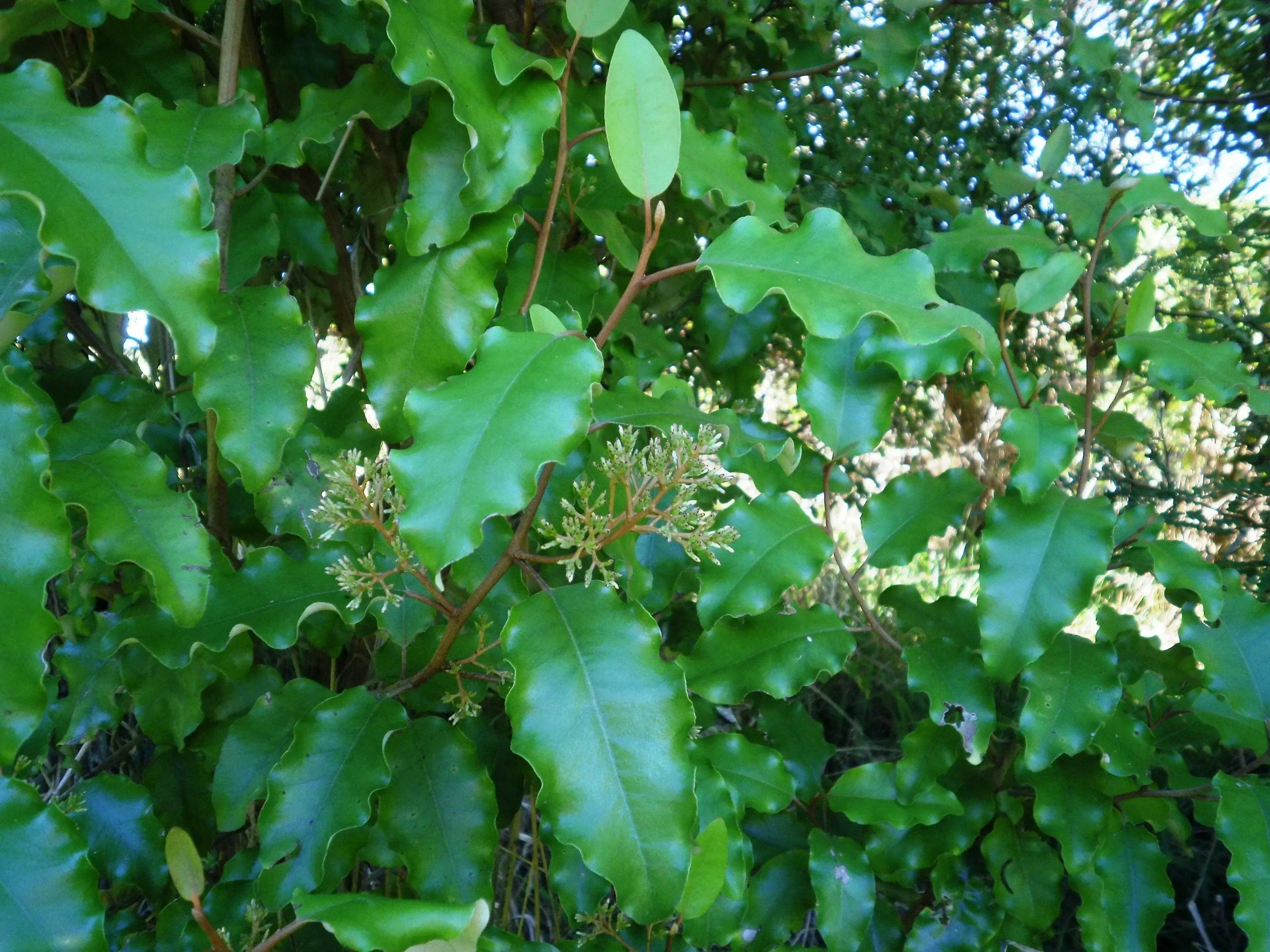
Fragrant Tree Daisy
Olearia fragrantissima
Fragrant Tree Daisy (scientific name: Olearia fragrantissima ) Fragrant Tree Daisy is a native tree daisy that produces masses of small white or cream flowers. Like other Olearia species, it's valued for its hardy nature and ability to provide shelter and nectar for native wildlife. Explore more in the native plants index .

Plant Description
Botanical Features
Fragrant Tree Daisy ( Olearia fragrantissima ) is a rare, endemic small bushy shrub or small semi-deciduous tree native to New Zealand's eastern and south-eastern South Island. It can reach heights of approximately 8 to 12 meters. Its branches are dark reddish-brown, ascending to spreading, with reddish-brown to red, rigidly wiry, flexuous (often zig-zagging), and interlacing branchlets. It has pale green, alternate leaves that are thin and oval in shape, measuring 7.5-40 mm long by 5-15 mm wide. The upper surface is glabrate to glabrous when mature, while the undersides are clad in a soft, white tomentum. During spring to early summer (October to December), it produces tiny, yellowish-green to cream or pale yellow, rayless flower heads in small, tight clusters. These flowers are strongly fragrant, emitting a scent akin to peaches or apricots, especially at night.
Quick Facts
Overview
Olearia fragrantissima is a rare and distinctive small bushy shrub or tree, celebrated for its unique apricot-peach scented flowers that bloom from spring to early summer. This endemic South Island species is recognized by its zigzag branches and small, pale green leaves.
| Scientific Name | Olearia Fragrantissima |
|---|---|
| Height | 2-6 m |
| Spread | 2-4 m |
| Water Needs | Low to moderate |
| Light | Full sun to partial shade |
| Frost Tolerance | Moderate to good |
| Salt Tolerance | Moderate |
| Growth Rate | Moderate |
| Lifespan | Long-lived |
Climate Best Suited to
Regional climate suitability across major New Zealand cities.
Regional Suitability
| Whangārei | Ideal |
| Auckland | Ideal |
| Hamilton | Suitable |
| Rotorua | Suitable |
| Tauranga | Ideal |
| Gisborne | Ideal |
| New Plymouth | Ideal |
| Whanganui | Ideal |
| Palmerston North | Suitable |
| Napier | Ideal |
| Wellington | Ideal |
| Nelson | Ideal |
| Christchurch | Suitable |
| Dunedin | Suitable |
| Invercargill | Suitable |
| City | Climate Suitability |
|---|
Natural Habitat
Fragrant Tree Daisy is endemic to the eastern and southeastern South Island of New Zealand, specifically from Banks Peninsula to Southland. It typically grows in coastal to lower montane areas, at elevations between 0 and 300 meters above sea level. Its natural habitats include grey scrub, forest margins, and shrublands. It can also be found on the margins of estuarine or salt-marsh vegetation, in areas that might be subject to saline water during extreme tides. Additionally, it grows on gravelly soils, often along the edges of steep gullies, gorges, and in boulder fields. This species prefers warm sites with fertile soils and is commonly found in diverse mixed forests. It is known to tolerate dry conditions and strong winds.
Plant Conservation
Conservation
Olearia fragrantissima , also known as the fragrant tree daisy or small-leaved tree daisy, is a plant species endemic to the South Island of New Zealand. The plant is currently classified as "At Risk - Declining" by the Department of Conservation's Threat Classification System, a status reported in 2017. Historically, it was listed as "Near Threatened" by the IUCN in 1998 and "Sparse" in 2004. An estimated total of over 10,000 Olearia fragrantissima plants exist across approximately 60 known sites. While two populations contain more than 1,000 plants, the majority of sites have populations ranging from single individuals to several hundred. The primary threats to Olearia fragrantissima include habitat loss, invasion by weeds, insufficient seedling recruitment, and browsing by animals. While some natural sites show adequate regeneration, recruitment is often limited in more modified areas. Conservation efforts include learning to identify the plant, reporting new populations, protecting existing populations through covenanting, fencing, weed control, and supplementary planting, and utilizing locally sourced plants in gardens, shelterbelts, and revegetation projects. Propagation from semi-hardwood cuttings and fresh seeds is a viable method to increase the plant's population.
Growing Requirements
Soil Requirements
Free-draining soils with organic matter. Avoid heavy, wet ground.
Light Requirements
Full sun to light shade; fragrance is best in warm, sheltered sites.
Water Requirements
Moderate moisture during establishment; drought-tolerant later.
Planting Guide
1. Ideal Growing Conditions:
- Sunlight: Prefers full sun to light shade. Fragrance is best in warm, sheltered sites.
- Soil: Requires free-draining soil with organic matter. It tolerates stony, sandy, and limestone soils, but avoid heavy, wet ground or waterlogged sites. A slightly acidic to neutral pH is generally suitable.
- Water: Moderate moisture during establishment. Once established, it is drought-tolerant. Water deeply but infrequently, allowing the soil to dry out between waterings.
- Climate: Tolerant of coastal conditions, strong winds, and moderate to good frost. It thrives in various New Zealand climates.
2. Planting:
- When to Plant: Transplanting thrives from early to late summer or during late fall due to milder temperatures, which minimizes stress and promotes healthy establishment. New stock can also be planted in spring.
- Spacing: For hedging, plant 50-80 cm apart for a fast, tight knit.
- Mulching: Apply a layer of organic mulch around the base of the plant to conserve moisture, suppress weeds, and regulate soil temperature.
Ecological Role
Olearia fragrantissima contributes fragrant floral resources and shelter to cool, moist shrublands and forest edges.
Pollination
- Insect attractant: Scented blooms draw pollinators, enhancing local pollination services.
- Wind-spread seed: Pappus aids dispersal into canopy gaps and slips.
Habitat Value
- Refuge: Dense branching offers cover for small birds and invertebrates.
- Soil moisture: Canopy shade reduces evaporation, supporting fern and moss layers.
By feeding insects and moderating microclimates, O. fragrantissima strengthens edge ecosystems.
Uses and Significance
Garden Applications
Olearia fragrantissima is highly valued for its distinctively scented foliage and deliciously apricot-peach scented flowers that create an enchanting nighttime fragrance. This attractive shrub excels as hedging, screening, or specimen planting, particularly in coastal and exposed sites where its hardy nature shines. Its tolerance of various conditions and drought resistance once established make it an excellent low-maintenance garden choice.
Ecological and Sensory Value
The fragrant white to pale pink flowers provide essential pollinator support, particularly for nocturnal pollinators attracted to the evening fragrance. This hardy evergreen's dense, bushy growth habit offers excellent shelter for small wildlife while contributing to New Zealand's native biodiversity. Its unique aromatic qualities make it especially valuable for sensory gardens and fragrant plant collections.
Cultural Significance
Cultural Importance
Mātauranga and Community Care
Direct rongoā specific to O. fragrantissima is limited in records, yet as a tree daisy it sits within akeake traditions of tough, serviceable wood. Today, Fragrant Tree Daisy is a focus for kaitiaki and community groups because remnant shrubs persist in dry gullies and limestone country. Programmes that fence stock, control rabbits and weeds, and propagate from local seed help retain the distinctive peach‑scented flowering that signals seasonal change for nearby communities and pollinators.
Olearia fragrantissima , also known as the Fragrant Tree Daisy, holds cultural significance primarily in New Zealand, where it is endemic. Its significance stems from several key aspects. The plant is highly valued for its unique aromatic qualities, particularly its "deliciously apricot-peach scented flowers" that release an "enchanting nighttime fragrance." This makes it a popular choice for sensory gardens and fragrant plant collections. It serves as an "excellent habitat plant for small native birds and invertebrates" and provides "essential pollinator support," especially for nocturnal pollinators attracted to its evening fragrance. Its dense, bushy growth also offers shelter for small wildlife and contributes to New Zealand's native biodiversity. Due to its hardy nature, tolerance to various conditions (including coastal and exposed sites), and drought resistance once established, it is used for hedging, screening, or as a specimen planting. It can also be used in riparian plantings and forests. Olearia fragrantissima is classified as an "At Risk - Declining" native shrub, highlighting its importance in conservation efforts within New Zealand. It is one of eight rare Olearia species included in the Small-leaved Tree Daisy National Recovery Plan, aiming to raise public awareness and encourage its protection and management.
Landscaping Ideas
Fragrant Tree Daisy ( Olearia fragrantissima ) is an exceptional native shrub that brings unique sensory appeal to landscaping projects through its remarkable apricot-peach nighttime fragrance. This hardy South Island endemic excels in challenging conditions and offers outstanding versatility for both formal and naturalistic garden designs, making it particularly valuable for coastal and exposed sites where many other plants struggle.
Sensory and Fragrant Gardens
- Moonlight gardens: Position near seating areas, pathways, or bedroom windows to maximize enjoyment of the distinctive evening fragrance that intensifies at dusk and throughout the night.
- Fragrant hedging: Create living boundaries that provide year-round structure while delivering seasonal bursts of heavenly scent, particularly effective for screening outdoor dining areas.
- Therapeutic gardens: Excellent choice for healing gardens and sensory spaces where the calming fragrance and tactile foliage can provide stress relief and mental wellbeing benefits.
- Entrance plantings: Welcome visitors with fragrant displays near doorways and gates, where the scent creates memorable first impressions and enhances the arrival experience.
Coastal and Exposed Site Solutions
- Windbreak establishment: Outstanding tolerance for strong coastal winds makes it invaluable for creating protective barriers that shelter more tender plants while establishing naturally resilient landscapes.
- Salt spray tolerance: Thrives in coastal conditions where salt-laden air damages other plants, providing reliable structure and seasonal beauty in challenging maritime environments.
- Erosion control: Root systems help stabilize banks, slopes, and coastal edges, while dense growth provides natural protection against wind erosion and soil movement.
- Pioneer planting: Excellent for establishing vegetation in difficult coastal sites, creating microclimates that enable other native species to establish and thrive.
Formal Landscape Applications
- Structured hedging: Dense, compact growth habit responds well to trimming, creating neat formal boundaries while maintaining flowering and fragrance potential with careful timing.
- Specimen features: Individual plants create striking focal points with distinctive zig-zagging reddish-brown stems, small pointed leaves, and abundant clusters of fragrant flowers.
- Foundation plantings: Low-maintenance nature and year-round appeal make it excellent for foundation beds, particularly in exposed locations where reliability is essential.
- Container cultivation: Adapts well to large containers for patios, terraces, and courtyards where mobility and controlled positioning enhance fragrance enjoyment.
Wildlife and Restoration Landscapes
- Pollinator gardens: Flowers provide crucial nectar for native bees and other pollinators, particularly valuable for nocturnal species attracted to the evening fragrance release.
- Habitat creation: Dense branching structure offers excellent shelter and nesting opportunities for small native birds and beneficial insects throughout the year.
- Conservation plantings: As an "At Risk - Declining" species, cultivation supports conservation efforts while contributing to authentic native plant communities and genetic diversity preservation.
- Edge plantings: Natural adaptation to forest margins makes it perfect for transitional areas between different habitat types in restoration projects.
Practical Landscape Benefits
- Drought tolerance: Once established, requires minimal irrigation, making it valuable for water-wise landscapes and areas with limited water resources or maintenance capacity.
- Year-round interest: Evergreen foliage provides consistent structure, while seasonal flowering and distinctive branch architecture create visual appeal throughout all seasons.
- Low maintenance requirements: Hardy nature and tolerance of neglect make it ideal for public spaces, commercial landscapes, and areas where minimal ongoing care is preferred.
- Adaptable spacing: Suitable for both mass plantings and individual specimens, allowing flexible design approaches from dense screening to scattered accent placement.
Seasonal Care Calendar
Spring
Tip-prune young plants to encourage a bushy shape and plant new stock in well-drained soil. Ensure adequate moisture during establishment to support vigorous growth.
Summer
Water deeply if conditions are dry, especially for young plants. Enjoy the unique apricot-peach fragrance of its flowers, which is most potent in the evenings.
Autumn
Perform light shaping after the main blooming period has finished. This helps maintain the plant's compact form and prepares it for the cooler months ahead.
Winter
Requires minimal care during winter. Ensure good drainage and protect young plants from severe frosts, although established plants are generally hardy.
Pruning and Maintenance
Techniques and Timing
Olearia fragrantissima responds well to regular light pruning to maintain its natural dense, compact form. Spring is the optimal time for shaping and trimming to encourage new growth and maintain size. Light clipping throughout the growing season helps preserve the plant's bushy habit and enhances flowering. While generally low-maintenance, avoid hard renovation cuts as this species prefers gentle management to maintain its characteristic fragrant flowering and sturdy foliage.
How to Grow Fragrant Tree Daisy
Fragrant Tree Daisy is an "At Risk - Declining" native shrub with deliciously fragrant apricot-peach scented flowers. This South Island endemic is characterized by its distinctive zigzag branches and small, glossy leaves. It is highly valued for its unique aromatic qualities and its ability to thrive in challenging, exposed sites. Understanding its propagation methods is key to successfully growing this important species and contributing to its conservation.
From Cuttings
Semi-hardwood cuttings are easily rooted and represent the most reliable propagation method for Fragrant Tree Daisy, ensuring that new plants retain the exact characteristics of the parent, including its unique fragrance. Take cuttings in autumn from healthy, non-flowering shoots. Treat with rooting hormone and maintain in a cold frame environment or a sheltered, humid location. The species roots readily with proper care and consistent moisture. This method preserves the parent plant's characteristics, including fragrance intensity, and is crucial for increasing the population of this "At Risk" species.
From Seed
Propagating Fragrant Tree Daisy from seed is a viable method, though it requires attention to seed viability as seeds have short-term storage life. Collect fine seed from dried flower heads in late autumn, storing in cool, dry conditions until sowing in spring. Surface-sow on a well-draining mix and keep evenly moist. Seeds respond well to 5-10 days of cold treatment prior to sowing, which improves germination rates. Provide protection from direct sunlight while maintaining consistent moisture levels. This method is important for maintaining genetic diversity within the species.
Pests and Diseases
Fragrant Tree Daisy ( Olearia fragrantissima ) is generally a hardy and resilient native shrub that experiences relatively few serious pest or disease problems when grown in appropriate conditions. Its natural adaptation to challenging South Island environments, including coastal exposure and alpine conditions, contributes to its overall robust health and natural resistance to many common garden problems.
Common Pest Issues
- Aphids: Small, soft-bodied sap-sucking insects that may cluster on new growth, particularly during spring growth periods. Can cause yellowing leaves and weakened growth. Monitor regularly and treat with insecticidal soap or neem oil if serious infestations develop.
- Scale insects: Appear as small, immobile bumps on stems and leaves, feeding on plant sap and potentially weakening the plant. Both soft and hard scale varieties may occasionally affect fragrant tree daisy. Treat with horticultural oil during active crawler stages.
- Spider mites: May occur during hot, dry conditions, causing stippled leaves and fine webbing. Increase humidity around plants and treat with insecticidal soap if infestations persist. Pay special attention to leaf undersides where mites often gather.
Environmental Stress Prevention
- Root rot prevention: The most critical aspect of maintaining healthy fragrant tree daisy is ensuring excellent drainage. Waterlogged conditions quickly lead to root rot and plant decline. Plant in free-draining soils and avoid heavy, wet ground or areas prone to water accumulation.
- Drought stress management: While drought-tolerant once established, prolonged dry periods without adequate moisture can cause leaf browning, reduced flowering, and overall stress. Provide deep, thorough watering during extended dry spells, especially for young plants.
- Cold and wet protection: Young plants can be less hardy during their first couple of winters. Overly cold and wet environments are not suitable, so consider protective fleece jackets for young specimens during harsh winter conditions.
Disease Resistance and Management
- Fungal disease resistance: Generally resistant to most common fungal infections due to its preference for well-draining soils and good air circulation. Ensure adequate spacing between plants to promote airflow.
- Leaf spot prevention: Avoid overhead watering which can create conditions favorable for leaf spot diseases. Water at soil level and remove any affected foliage promptly to prevent spread.
- Powdery mildew avoidance: Good air circulation and avoiding overcrowded planting helps prevent powdery mildew. Remove any affected growth and improve ventilation around plants.
Integrated Management Approach
- Cultural practices: The best defense against pest and disease problems is maintaining optimal growing conditions. Provide free-draining soil, appropriate spacing, and avoid overwatering or overfertilising which can attract pests.
- Organic pest control: Use organic options such as insecticidal soaps, neem oil, and horticultural oils for pest management while minimizing harm to beneficial insects that are attracted to the fragrant flowers.
- Regular monitoring: Check plants regularly for early signs of pest or disease problems, particularly during active growing seasons. Early intervention is more effective than treating established problems.
- Beneficial insect support: The fragrant flowers naturally attract beneficial insects that help control pest populations. Avoid broad-spectrum pesticides that may harm these natural predators.
Regular monitoring combined with appropriate cultural practices will prevent most potential problems and keep fragrant tree daisy plants healthy and vigorous throughout their growing season.
Bonus Tip
Expert Growing Advice
To fully appreciate the unique apricot-peach scent of Olearia fragrantissima, strategically site it near pathways, patios, or open windows, ideally on the lee side of prevailing winds. This placement allows the evening fragrance to linger and provides essential shelter, promoting a more extended and spectacular flowering display even in exposed, dryland sites.

